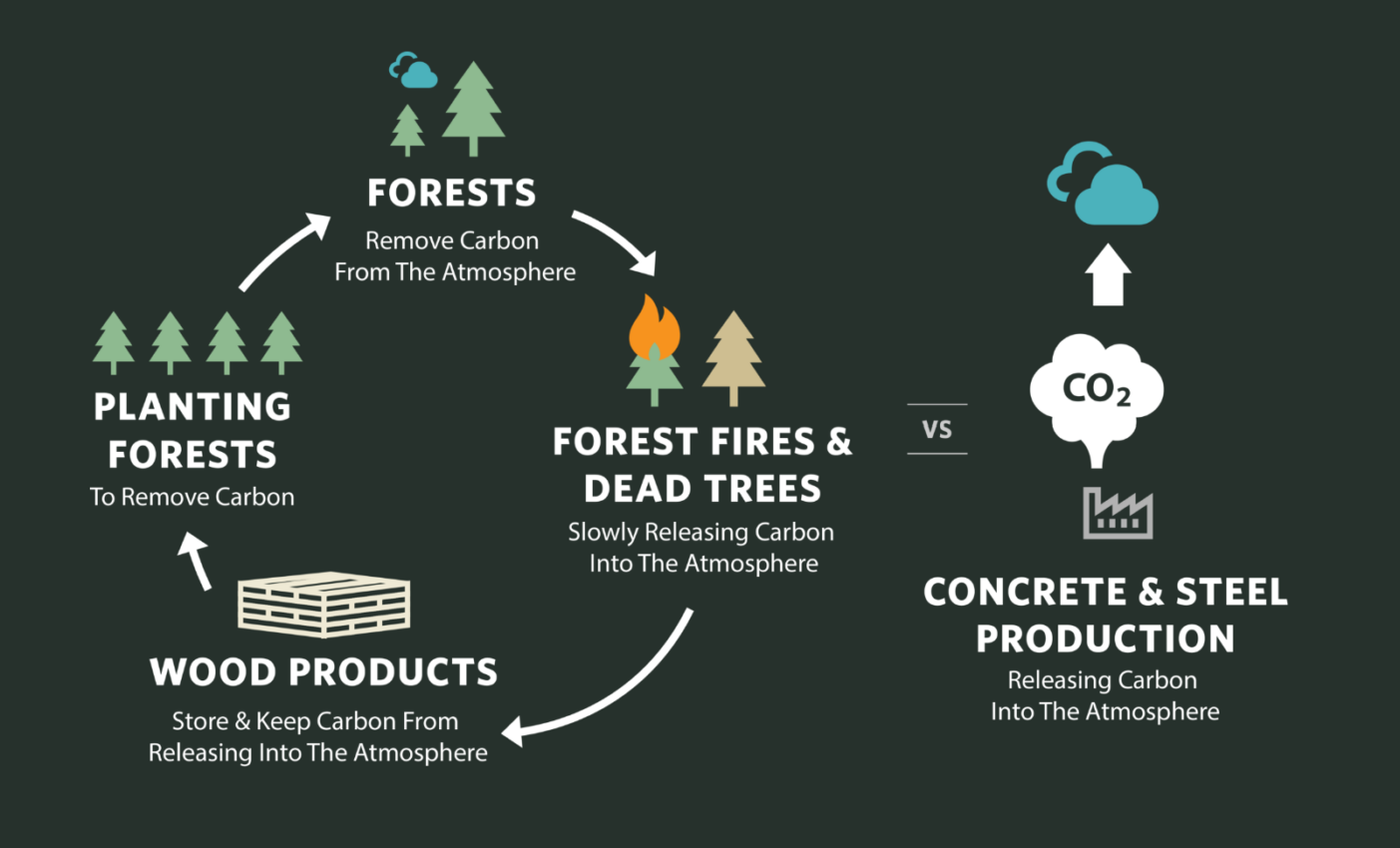Wood is a natural material, which grows with solar energy, and therefore easy to manufacture with low carbon emissions.
It has always existed, and we have used it in construction for centuries.
However, at the end of the 19th century, the irruption of reinforced concrete brought about a technological revolution in the construction industry, far surpassing the structural performance of wood, which, when subjected to a great directional force along its fiber, reveals its instability (especially when compared to reinforced concrete).
To make matters worse, 40/50 years ago, the environmental crisis focused on deforestation (rather than carbon footprint) and the use of wood and its derivatives were demonized.
A greater understanding of the climate crisis, and a better focus on the causes of it, has changed the popularity of wood, and this has coincided with a growing timber industry focused on sustainable and responsible reforestation.
The birth of the CLT (Cross Laminated Timber) construction system, which simply consists of gluing several layers of wood together, arranging the fibers of these panels in a crosswise manner, has given wood the rigidity it lacked, and the CLT system has become the most suitable material for sustainable construction projects.
What does this mean for the construction industry?
We could say that it gives us all the advantages we need to face the challenges of the century we live in:
- Great strength and versatility when it comes to design
- Structural load-bearing capacity, even in extreme conditions such as humidity and fire
- Low energy consumption during production
- Zero harmful residues during deactivation

Graphic. Source: Carbón12
What more can you ask from a material?
In these almost 10 years, interesting works of architecture have been built with CLT , but leaving aside the iconic architecture, and concentrating on the silent buildings, of accompaniment, that make the backdrop of our cities, and are neither more nor less than our homes and offices, today we answer questions of domestic architecture:
WHAT ELEMENTS CAN BE MADE WITH CLT?
The plywood can be used in most of the constructive elements that define the structure and the enclosure of a house: walls, floors, decks, stairs.
Walls in general. Whether they are exterior, party walls or interior, reaching up to 14 meters of continuous height (3 floors) and the possibility of superimposing other elements on top, if the project exceeds this height.
Mezzanine floors and roofs, with great versatility, due to its capacity to cover large spans avoiding the use of pillars.
WHAT ARE ITS ADVANTAGES OVER TRADITIONAL CONSTRUCTION?
The most outstanding points compared to other construction systems range from its advantages due to its excellent technical performance, to its environmental impact and its impact on economic savings.
Here is a review of some of these benefits:
1. Speed of execution.
Thanks to the precision and ease of handling of the plates, the estimated time for the assembly of a 200 m2 house would be 10/12 days. The manufacturing work in the workshop takes 2 months, which is usually carried out simultaneously with the execution of the on-site foundations.
2. Clean architecture.
Given the extraordinary strength of the cross-laminated panel, it is not necessary to use reinforcing elements such as pillars and beams, which often create thermal bridges or unnecessary obstacles.
3. Excellent strength-to-weight ratio.
A 12 cm thick panel is capable of covering 4 meter spans with a load of 400 kg/m2. This piece has a weight of 60 kg/m2. In global figures, this means that a 200 m2 structure has an approximate weight of 17 tons. This same structure built in concrete would have a weight of 85 tons, without being able to withstand the loads mentioned above. This feature considerably reduces foundation costs, allows the construction of large cantilevers and open spaces, free of columns and beams, and together with the flexibility improves the behavior in the event of earthquakes.
This high static efficiency (high load-bearing capacity with a very low dead weight) allows the construction of large cantilevers and open spaces, free of columns and beams.
This “lightness” reduces the foundation requirements in the building, reducing the final costs of this chapter.
4. High thermal and acoustic performance.
No material used for the realization of structures is as insulating as the cross-laminated panel, its transmission coefficient is 0.13 W/mºC (12 times more insulating than a concrete structure).
At the acoustic level, the porous composition of the wood and its density allow it to absorb sound waves, preventing them from passing through the material.
5. Indoor air quality.
Absence of water during construction, reduced thermal conductivity, and high hygroscopicity result in healthy and comfortable environments.
In traditional construction, thousands of liters of water are used, which evaporate during the first years of the building’s life, resulting in higher heating consumption and an inappropriate indoor humidity level for users. With a cross-laminated panel structure, the humidity percentage of the pieces is guaranteed at a maximum of 14%, achieving healthy and comfortable interiors.
In addition, CLT panels have a reduced thermal conductivity, behaving in a similar way to an insulating material, but with the advantage of having a much higher density, which gives them greater thermal inertia that effectively ensures environmental comfort inside a building, both in summer and winter.
Wood is a naturally hygroscopic material that has the ability to regulate environmental humidity.
When the relative humidity of an environment increases, wood walls or floors absorb water vapor, which is released again when the air is dry.
This inherent quality of the material is a natural humidity control system that stabilizes the indoor environment, favoring the creation of healthy spaces.
It has also been proven that by absorbing the vapor, harmful substances are eliminated from the air, which remain fixed in the wood and are not re-emitted during subsequent evaporation.
6. Low environmental impact.
As the title of our article states, wood is a material that grows with renewable energy. Trees store CO2 in their photosynthesis process, and even if we subtract the emissions produced during its transformation and transportation, the result is always positive.
In addition, it is a material with low energy consumption in its manufacture, which considerably reduces greenhouse gas emissions compared to concrete or steel,
Waste generation is also reduced. Being a prefabrication system in a workshop, the process is planned with greater rigor, optimizing the use of the material, and reducing the amount of waste and scrap.
And although we do not think about it when we are starting, it is interesting to note that at the end of its useful life, it can be easily disassembled and reused, becoming a system aligned with the circular economy, so relevant in the current climate crisis scenario.
IMPORTANT: the wood (raw material) must come from forestry operations with chain of custody certification, which is a seal that certifies that the wood comes from sustainably managed and environmentally responsible forests.
7. Fire resistance.
Fire resistance in a wood structure basically consists of knowing the resistant section and the section that will be sacrificed in case of fire. The general approach for a structure of these characteristics is that the necessary thickness to comply structurally with the loads that it will support would be 6 cm. If the structure is to be exposed directly to the interior without any cladding, the carbonization rate of 0.67 mm/min must be taken into account. With this data we can calculate that a structure exposed to intense fire would lose in 30 minutes the result of multiplying the speed by the exposure time (30 minutes x 0.67 mm/min) 20.1 mm of sacrificed section, this greatly facilitates the calculation of fire resistance of a solid wood structure, since by oversizing thicknesses, practically unlimited REI times can be achieved.
8. Guarantee of absence of fungi and xylophages.
The panel is certified with a humidity percentage of no more than 14%, this together with a correct execution is a guarantee against the possible presence of fungi and xylophagous, since being dry wood is not nutritious for external agents. In addition, a broad-spectrum biocide treatment for risk class 3 is applied in high-risk areas, as a preventive treatment with fungicidal and insecticidal effect, according to UNE-EN 927 1/2/3/4/5 standard.
And as important as all the above:
HOW MUCH DOES IT COST TO BUILD WITH CLT?
Speaking of costs, a CLT panel structure (fully assembled) is around 450 €/m2 (+/- 10%), depending on the size and/or complexity of the structure. We have to take into account that the CLT, besides being a structure, is also an enclosure and incorporates insulation that has an impact on the savings of other items.
Curious fact:
Carbon 12, is one of the tallest buildings in the world (18 floors) built with the CLT system. And the company shares on its website, the construction process and the experience of those who have participated in it, predicting a bright future for this carbon-free system.
Some of the diagrams that illustrate our article belong to this website.
